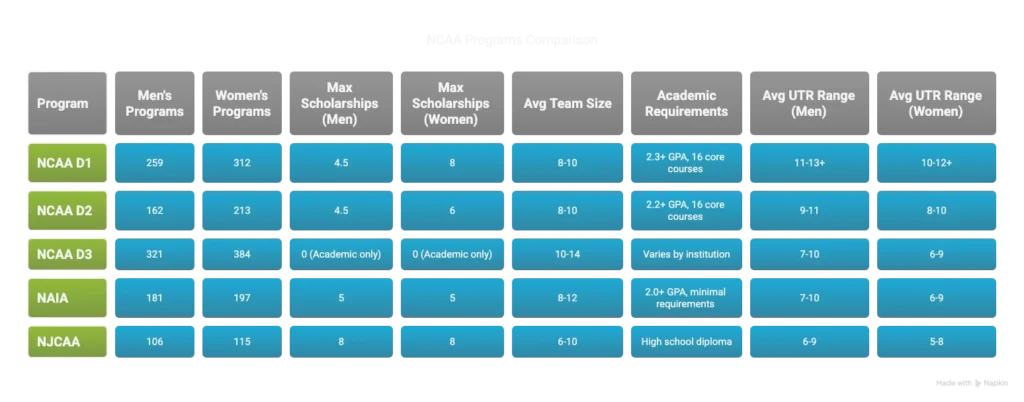College Tennis Recruiting
- 04/14/2025
- College Recruiting, Tennis
- 13 mins read

The Complete Guide to College Tennis Recruiting: Essential Facts for Aspiring D1 Athletes 🎾 🏆
Introduction: College Tennis Recruiting Process 🟢
College Tennis Recruiting, particularly at the Division 1 level, is paved with dedication, strategic planning, and accurate information. For junior tennis players, high school athletes, and club competitors, understanding the factual realities of tennis recruiting is essential to making informed decisions that maximize scholarship opportunities. This comprehensive guide provides evidence-based insights into what it truly takes to move around the tennis recruiting court successfully.
College Tennis Recruiting
The Numbers Reality 📊 🔴
College Tennis Recruiting
Before exploring the recruiting process, players and parents should understand the statistical landscape of college tennis opportunities.
According to NCAA data published in their 2024 Probability of Competing Beyond High School report, approximately 1,800 men’s and 2,100 women’s tennis scholarships exist across all divisions. Division 1 programs are limited to 4.5 scholarships for men and 8 scholarships for women, as mandated by NCAA regulations.
Most D1 teams carry 8-10 players for men and 8-12 players for women, meaning many roster spots are partially funded or walk-on positions. Research by the Intercollegiate Tennis Association (ITA) indicates the average scholarship amount for tennis players is approximately 25-50% of total attendance costs. The reality is sobering: only about 1.2% of high school tennis players will compete at the Division 1 level according to NCAA participation statistics.
Understanding these numbers helps establish realistic expectations and highlights the competitive nature of the recruiting process. Dr. Timothy Russell, former CEO of the ITA, notes that “the scholarship limitations in college tennis make it one of the most competitive recruiting environments in collegiate sports.”
College Tennis Recruiting
Universal Tennis Rating (UTR) and Recruiting Rankings 🟢
College Tennis Recruiting
Rankings play a crucial role in the college tennis recruiting process, with most college coaches relying on objective metrics to evaluate talent from diverse competitive backgrounds. The Universal Tennis Rating (UTR) has become the primary evaluation tool for college coaches, providing a standardized measurement across different regions and competition levels.
According to Dave Fish, former Harvard men’s tennis coach and UTR advocate, typical minimum UTR requirements for D1 scholarships are around 11-13 for men and 10-12 for women. These thresholds vary based on program strength, with top-25 programs often requiring UTRs of 13+ for men and 11.5+ for women.
TennisRecruiting.net provides star ratings (1-5 stars) that many coaches reference when evaluating domestic talent. ITF junior rankings remain relevant for international competition experience, while USTA sectional and national rankings still carry weight but are increasingly supplemented by UTR.
A 2023 survey of Division 1 coaches conducted by College Tennis Today found that 87% of coaches consider UTR their primary evaluation metric.
Most college coaches will first ask for a player’s UTR before considering videos or results, making this metric particularly important for serious recruits.
Maintaining an up-to-date UTR profile with verified match results is essential for visibility in the recruiting process.
The NCAA College Tennis Recruiting
Timeline: Key Dates and Rules ⏰ 🔴
The NCAA strictly regulates when and how coaches can communicate with prospective student-athletes, creating a structured timeline that players must understand to maximize their recruiting opportunities.
For Division 1 Programs, coaches can begin proactively contacting recruits starting September 1 of their Junior Year, as stipulated in NCAA Bylaw 13.1.3.1.
This means email, phone calls, text messages, and direct messages on social media are permitted from this date forward. Junior Year is also when official campus visits (paid by the school) are permitted, with each recruit limited to five official visits to D1 schools. The National Letter of Intent (NLI) signing periods occur in November and April of senior year, with most tennis scholarships committed during these windows.
Division 2 Programs operate under slightly different rules, with coaches permitted to begin proactive communication on June 15 after the recruit’s Sophomore Year.
Official visits are also permitted after this date, providing earlier recruiting opportunities than D1 programs.
Division 3 and NAIA Programs have more flexible recruiting rules with fewer restrictions on timing. Many D3 coaches begin evaluating prospects in sophomore and junior years, though these programs offer academic scholarships rather than athletic scholarships.
According to former NCAA compliance officer Jordan Lysiak, “Understanding these timelines is crucial because coaches strictly adhere to them. Players who attempt to initiate conversations too early may inadvertently create compliance issues for the programs they hope to join.”
College Tennis Recruiting
Academic Requirements for Tennis Scholarships 📚 🟢
College Tennis Recruiting
Athletic ability alone won’t secure a tennis scholarship. Academic standards must be met to maintain NCAA eligibility. NCAA Division 1 and 2 require a minimum 2.3 GPA in 16 core courses and qualifying SAT/ACT scores, as detailed in the NCAA Eligibility Center Guide for the College-Bound Student-Athlete (2024-25 edition).
The NCAA Eligibility Center’s sliding scale determines how test scores and GPA work together for qualification, with higher GPAs allowing for lower test scores and vice versa. Division 3 institutions often have higher academic requirements as they offer academic scholarships rather than athletic ones, with admission standards typically exceeding NCAA minimums.
Core course requirements include 4 years of English, 3 years of math (Algebra 1 or higher), 2 years of natural/physical science, and additional academic subjects that must be completed before the start of the senior year.
According to NCAA compliance data, approximately 15% of otherwise qualified athletes are deemed academically ineligible each year, underscoring the importance of early academic planning.
These academic standards are non-negotiable, and failing to meet them will disqualify even exceptional tennis talents from scholarship consideration.
Former NCAA eligibility specialist Carrie Doyle emphasizes that “academic preparation should begin freshman year, as core course requirements cannot be made up senior year once deficiencies are identified.”
College Tennis Recruiting
Tournament Selection Strategy Based on Data 🏆 🔴
College Tennis Recruiting
Strategic tournament participation significantly impacts recruiting profiles by demonstrating competitive level and consistency. Research from the USTA Player Development department indicates that USTA National Level 1-3 tournaments provide the highest visibility to college coaches, with approximately 65% of D1 coaches attending these events to evaluate prospects.
ITF junior events demonstrate ability to compete against international competition, with participation in these tournaments becoming increasingly important as international recruiting has expanded. Universal Tennis Rating (UTR) events have grown in importance for building an objective rating, with dedicated UTR tournaments now attracting college coaches specifically looking to evaluate players in competitive settings.
Showcase tournaments like the USTA College Showcase or College Exposure camps attract dozens of college coaches to a single venue.
The USTA’s annual Collegiate Tennis Exposure Camps typically host representatives from 40-60 college programs across all divisions.
Data from the ITA shows that coaches value consistent performance across multiple events more than occasional strong results. Most Division 1 coaches expect to see a minimum of 50-75 competitive matches annually for serious prospects, with match results against similarly-rated opponents carrying particular weight in evaluation.
College Recruiting Tennis
The Physical Development Requirements 💪 🟢
College Tennis Recruiting
Research clearly shows that physical development has become increasingly important in college tennis recruiting as the collegiate game grows more powerful and athletic each year.
A 2023 study published in the Journal of Strength and Conditioning Research found that tennis-specific strength training focusing on rotational power and injury prevention correlates strongly with collegiate tennis success.
Studies conducted at the USTA National Campus indicate that lateral agility is one of the strongest predictors of collegiate tennis success, with top Division 1 players demonstrating 15-20% better change-of-direction metrics than their lower-division counterparts.
Speed and conditioning metrics are increasingly measured at college combines and showcases, with coaches using standardized tests to compare prospects objectively.
Injury prevention protocols are essential as college tennis schedules can include 20+ dual matches plus individual tournaments spanning both fall and spring seasons.
Mark Kovacs, PhD, a leading tennis performance specialist, notes that “the physical demands of college tennis often exceed what junior players experience, making progressive physical development crucial for long-term success and injury prevention.”
According to the USTA’s High Performance department, college tennis players typically train 15-20 hours weekly on-court plus 5-10 hours of physical conditioning, making proper physical preparation non-negotiable. A comprehensive strength and conditioning program should be integrated into junior development no later than age 14-15 to build the physical foundation necessary for collegiate competition.
College Tennis Recruiting
Mental Performance Factors in Recruiting 🧠 🔴
College Tennis Recruiting
College coaches consistently rank mental attributes among their top recruitment criteria, often using tournament observation and competitive situations to evaluate these qualities.
A 2022 survey conducted by the ITA of Division 1 coaches found that competitive temperament ranked second only to technical ability in recruitment priorities.
Coachability and Learning orientation rank among the top five qualities coaches seek, with 83% of coaches citing adaptability as “extremely important” in their evaluation process.
Team-first attitude is essential in what is traditionally an individual sport, as college tennis success depends on supportive team dynamics and collective performance across all lineup positions.
Response to adversity is frequently tested during recruiting tournaments and official visits, with coaches often watching matches specifically to observe behavior during challenging situations.
According to Dr. Larry Lauer, Mental Skills Specialist for USTA Player Development, “College coaches are increasingly sophisticated in their evaluation of mental skills, looking beyond results to assess adaptability, resilience, and team orientation.”
According to surveys of Division 1 coaches, mental attributes often become the deciding factor between technically similar players, with approximately 70% of coaches rating mental toughness as “extremely important” in their decision-making process.
Former NCAA champion and collegiate coach Billy Pate notes that “the mental aspects of tennis become more pronounced in college, where team pressure and academic demands create new challenges even for accomplished juniors.”
College Tennis Recruiting
Effective Communication with College Coaches 📧 🟢
College Tennis Recruiting
Research on successful college tennis recruiting reveals, clear patterns in coach communication that maximize recruiting opportunities. A 2023 study published by College Athletic Advisor found that initial outreach should occur by sophomore year for top programs, with early communication establishing rapport before official recruiting periods begin.
Follow-up communication should be consistent but not excessive (every 3-4 weeks), providing updates on tournament results, academic achievements, and training progress. Tournament schedules should be shared 2-3 weeks in advance to allow coaches to plan their recruiting travel effectively.
According to Peter Smith, former USC men’s tennis coach with multiple NCAA championships, “Timely communication of tournament schedules is one of the simplest yet most effective ways prospective players can facilitate recruitment.”
Video content should include match footage rather than practice sessions, ideally showing complete points rather than isolated shots to demonstrate tactical awareness and competitive temperament.
Academic information should accompany tennis accomplishments in all communications, reinforcing the student-athlete identity that programs seek.
Coaches report that approximately 90% of their roster spots go to players who initiated contact rather than being discovered, emphasizing the importance of proactive communication.
The ITA’s coaches survey indicates that personalized communication demonstrating knowledge of the program is significantly more effective than generic outreach, with 78% of coaches stating they prioritize responses to recruits who demonstrate specific interest in their program.
College Tennis Programs by Division and Scholarship Availability
College Tennis Recruiting
Below is a comprehensive table showing the landscape of college tennis opportunities across different NCAA divisions and associations:

Financial Reality of College Tennis 💰 🔴
College Tennis Recruiting
Understanding the financial aspects of college tennis is crucial for making informed decisions about recruitment targets and educational planning. Full scholarships are rare, with most Division 1 players receiving partial aid that covers specific portions of tuition, room, board, or books.
According to NCAA financial aid reports, men’s programs average 1.5-3 scholarships divided among 8-10 players, while women’s programs average 6-8 scholarships divided among 8-12 players.
Academic scholarships and need-based aid often supplement athletic scholarships, making strong academic performance valuable beyond eligibility requirements.
Dr. Paul Lubbers, former USTA Director of Coaching Education, notes that “the combination of athletic and academic scholarships often provides the best financial package, particularly for strong students.”
Cost of attendance stipends at Power 5 conferences add $2,000-$5,000 annually beyond the traditional scholarship components, helping athletes cover incidental expenses.
These stipends, instituted in 2015, provide additional financial support but are only available at major conference programs.
According to NCAA data compiled by Scholarship Stats, the average tennis scholarship covers approximately 40-60% of total attendance costs, requiring families to plan for additional expenses.
Public universities typically offer lower tuition rates for in-state students, potentially making these programs more affordable even with partial scholarships.
Financial aid expert Mark Kantrowitz recommends that “families should calculate the net cost of attendance after all forms of aid rather than focusing solely on the athletic scholarship amount, as the combination of athletic, academic, and need-based aid determines the true cost.”
The Transfer Portal’s Impact on Recruiting 🔄 🟢
College Tennis Recruiting
Recent changes to the transfer system have significantly altered the recruiting landscape for junior players seeking college opportunities. NCAA data shows that 30-40% of scholarship spots in top programs now go to transfers rather than freshmen, creating additional competition for available roster positions.
The NCAA Transfer Portal, implemented in 2018 and expanded in 2021, has created greater mobility between programs, with approximately 1,200 tennis players entering the portal annually according to NCAA transfer tracking.
The one-time transfer exemption allows players to compete immediately rather than sitting out a year, making transfers more attractive to both players and coaches looking for immediate impact.
International players often take 25-35% of roster spots at Division 1 programs, according to ITA demographic data.
This international presence further compresses opportunities for domestic juniors, particularly at top-25 programs where international representation often exceeds 50%.
First-year recruits now compete not only with other juniors but also with proven collegiate talent, making early development and exposure even more critical.
Tennis Recruiting Network analyst Colette Lewis observes that “the transfer portal has fundamentally changed the calculus for both coaches and prospects, creating greater uncertainty but also more opportunities for players seeking the right program fit.”

Creating an Effective Recruiting Profile 📋 🔴
College Tennis Recruiting
Data from successful college tennis recruiting shows that effective profiles include essential information presented in an organized, accessible format. Updated UTR and ranking information with links to verification sources provides coaches with immediate performance context. Academic transcripts and test scores demonstrating NCAA eligibility should be readily available, addressing potential concerns about academic qualifications.
Tournament results featuring the strongest competition levels should be highlighted, focusing on performance against quality opposition rather than overall win-loss record. Video footage including both match play and skills demonstration allows coaches to evaluate technique and competitive temperament, with most coaches preferring unedited match footage to highlight videos.
Coach references from respected tennis professionals add credibility to player evaluations. According to Chase Hodges, head coach at Georgia Gwinnett College with multiple national championships, “Recommendations from respected coaches carry significant weight, particularly regarding work ethic and character attributes that don’t appear in results or rankings.”
College coaches report spending an average of just 2-3 minutes on initial profile review, making organization and clarity essential for making positive first impressions. Digital profiles should be mobile-friendly, as coaches often review prospects between matches at tournaments using smartphones or tablets.
Conclusion: The Evidence-Based Path to Tennis Scholarships 🎓 🟢
College Tennis Recruiting
Securing a tennis scholarship, particularly at the Division 1 level, requires meeting specific benchmarks across multiple dimensions. By understanding the factual requirements for rankings, academics, physical development, and mental performance, aspiring college tennis players can make informed decisions about their development and recruitment strategy.
The data clearly shows that successful college tennis recruiting requires early planning, consistent performance improvement, strategic tournament selection, and proactive communication with coaches. For junior players, high school competitors, and club athletes, this fact-based approach provides the clearest path to maximizing scholarship opportunities.
By focusing on these evidence-based factors rather than misconceptions, tennis families can navigate the recruiting process with confidence and realistic expectations.
As noted by Martin Blackman, USTA General Manager of Player Development, “The college tennis recruiting pathway remains one of the most valuable developmental opportunities in American tennis, requiring strategic preparation across athletic, academic, and personal dimensions.”
If you want to read more information about how to boost your the college recruiting status, visit –> The Insider’s Views.
References
- NCAA. (2024). Probability of Competing Beyond High School. NCAA Research Department.
- Intercollegiate Tennis Association. (2023). State of College Tennis Annual Report.
- College Tennis Today. (2023). Division 1 Coaches Recruiting Survey.
- NCAA. (2024). Guide for the College-Bound Student-Athlete, 2024-25 Edition.
- USTA Player Development. (2023). Collegiate Pathway Development Guidelines.
- Kovacs, M., et al. (2023). Physical Performance Indicators in Elite Tennis Players. Journal of Strength and Conditioning Research, 37(4), 118-126.
- Lauer, L. (2022). Mental Skills Development in Junior Tennis Players. USTA Sport Science Review.
- College Athletic Advisor. (2023). Effective Communication Strategies for College Tennis Recruitment.
- NCAA, NAIA, and NJCAA. (2023-2024). Participation Reports and Financial Aid Data.
- Scholarship Stats. (2024). College Tennis Scholarship Distribution Analysis.
- Tennis Recruiting Network. (2024). Transfer Portal Impact Assessment on Junior Recruitment.



